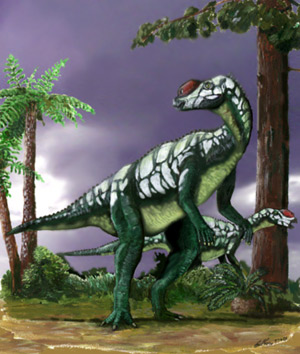
|
Search JoyZine with Google Site Search! |
Muttaburrasaurus
Muttaburrasaurus means "Muttaburra lizard", as it was first found on Rosebury Downs station beside the Thompson river near the town of Muttaburra in Queensland, in 1963. It was discovered by a local grazier, Mr D Langdon of Muttaburra. The fossil remains had been scattered about by the feet of cattle for years, and some of the locals had taken pieces home with them. Once the importance of the find was known the locals were asked to return the material they had souvenired, and most was recovered. At the time it was the most complete dinosaur skeleton found in Australia (now surpassed by Minmi paravertebra, an ankylosaur from the same region). Muttaburrasaurus lived during the Middle Cretaceous period, about 113-97.5 million years ago. It was a herbivore similar to Iguanodon (if not closely related) that spent most of its time on all fours, but could raise up onto its hind legs to feed or to run fast from predators. It was about 7m long and weighed 1-4 tons. It had an unusual wide, low skull with a hollow chamber on top of its snout, which may have been associated with its sense of smell or its ability to make sounds. The exact relationships of Muttaburrasaurus are unclear, although it appears to be a basal ornithopod more derived than Tenontosaurus. It may be related to the dryosaurs, including the basal ornithopod Gasparinisaura cincosaltensis from the Late Cretaceous of South America. There seem to be many basal dryomorph dinosaurs known from Gondwanan countries, such as Dryosaurus lettowvorbecki and Kangnasaurus coetzei from Africa, and an Antarctic "dryosaur" specimen. In 1987 a second skull was collected from Dunluce station, between Hughenden and Richmond in north-central Queensland, by Mary Wade. The skull was quite badly crushed, but appears more complete than the original. Given the slight age difference of a million years or so, and its generally more primitive features, this skull may not belong to the same species as Muttaburrasaurus langdoni, so has been designated as a Muttaburrasaurus sp, meaning that it probably belonged to the same genus but may be a different species. Most iguanodontids had daggar-like spikes for thumbs and serrated beaks with strong jaw muscles, both of which would have been useful in fending off predatory theropods. It is not known whether Muttaburrasaurus had thumb spurs, indeed its original classification as an iguanodont is in doubt. An incomplete flattened, tapering element was initially thought to have been a fragment of thumb spur, but given its broken and abraded appearance and the fact that most of the skeleton shows little similarity with iguanodontids, there is little evidence for the presence of a thumb spur. If Muttaburrasaurus did indeed lack a thumb spur, then it may have relied on its large size and strong bite as its main defenses if cornered by a predator or a rival. Muttaburrasaurus seems to have been one of the most widespread dinosaurs known from Australia. As well as the two specimens discussed above, fragments of a third have been found at Iona, also near Hughenden. Two teeth from Lightning Ridge in New South Wales may also have belonged to Muttaburrasaurus. The jaw muscles of Muttaburrasaurus would have been unusually strong. The rear section of the skull, where the jaw muscles attached, is much deeper than in most other ornithopods. Muttaburrasaurus seems to have replaced its teeth all at once and as needed, rather than one at a time, so that the tooth row formed a continuous shearing surface rather than a grinding one. It has been suggested that Muttaburrasaurus may have been partially carnivorous. Or perhaps these adaptations were for eating tough vegetation that other dinosaurs found difficult to chew, such as cycads, which were common in this part of Australia at the time. If so it may have meant less competition for food from other herbivores. Iguanodontids in general have the distinction of probably being the first dinosaurs that could chew efficiently. Their descendants, the hadrosaurs and lambeosaurs, took this adaptation to the extreme, having several hundred self-sharpening teeth active in the jaw at any one time, with several rows of inactive teeth waiting below the gum line to replace them as they wore out. The only other dinosaurian herbivores that could match this feat of chewing efficiency were perhaps the horned ceratopsians. Most other dinosaur plant eaters had a surprisingly primitive tooth structure. Although Muttaburrasaurus seems to be neither iguanodontid nor a hadrosaur, it may represent a line of ornithopods that diverged from the iguanodont-hadrosaur line sometime before the divergence of Tenontosaurus. Phylum Chordata (having a hollow nerve chord ending in a brain); Class Archosauria (diapsids with socket-set teeth, etc.); Order Ornithischia—beaked, bird-hipped dinosaurs that were plant-eaters; Suborder Ornithopoda; Infraorder Iguanodontia (having spiked thumbs); Genus Muttaburrasaurus Species M. langdoni (type species named by Ralph E. Molinar and Alan Bartholomai, 1981). |
